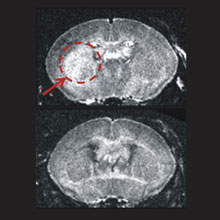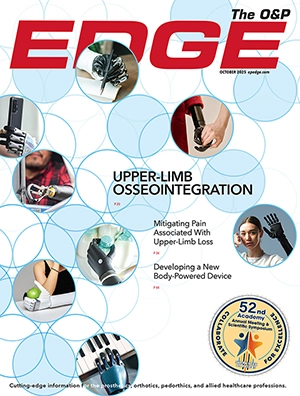Scientists at Washington University School of Medicine in St. Louis, Missouri, have shown that a protein may help prevent the kind of brain damage that occurs in babies with cerebral palsy (CP).
Using a mouse model that mimics the condition in newborns, the researchers found that high levels of the protective protein, Nmnat1, substantially reduce damage that develops when the brain is deprived of oxygen and blood flow. The finding offers a potential new strategy for treating CP as well as strokes, and perhaps Alzheimer’s, Parkinson’s and other neurodegenerative diseases. The research is reported online in the Proceedings of the National Academy of Sciences.

MRI scans of damage from a mouse cerebral palsy model show less damage in mice with higher levels of the protective protein Nmnat1 (bottom image). Scientists are investigating how the protein works, hoping to activate the same protective mechanisms with drugs to block several causes of brain injury. Image courtesy of Washington University School of Medicine in St. Louis, Missouri.
The protective effects of Nmnat1 were first identified five years ago by Jeff Milbrandt, MD, PhD, the James S. McDonnell professor and head of the Department of Genetics, professor of neurology and professor of pathology & immunology and internal medicine at Washington University, who showed the protein can prevent damage to peripheral nerves in the body’s extremities. Phillip Verghese, PhD, a postdoctoral research associate wanted to see if the protein’s protective effects extend to the brain.
“Cerebral palsy is sometimes attributable to brain injury that stems from inadequate oxygen and blood flow to the brain before, during, or soon after birth,” Verghese says. “We wanted to see if those injuries still occur in the presence of increased levels of Nmnat1.”
“Under normal circumstances, the brain can handle a temporary disruption of either oxygen or blood flow during birth, but when they occur together and for long enough, long-term disability and death can result,” says senior author David M. Holtzman, MD, the Andrew and Gretchen Jones professor and chairman of neurology, professor of developmental biology, and associate director of the Alzheimer’s Disease Research Center, in whose laboratory Verghese worked. “If we can use drugs to trigger the same protective pathway as Nmnat1, it may be possible to prevent brain damage that occurs from these conditions as well as from neurodegenerative diseases.”
The researchers aren’t exactly sure how Nmnat1 protects brain cells, but they suspect that it blocks the effects of the powerful neurotransmitter glutamate. Brain cells that are damaged or oxygen-starved release glutamate, which can overstimulate and kill neighboring nerve cells.
The researchers evaluated the effects of oxygen and blood flow deprivation in normal mice and in mice genetically engineered to produce higher-than-normal levels of Nmnat1. As early as six hours later, the mice with enhanced Nmnat1 had markedly less injury to the brain.
A week later, when the researchers measured the amount of tissue atrophy in the brain, they found that mice with high Nmnat1 had experienced far less damage to key brain structures like the hippocampus and cortex, which are known to be injured in CP.
In a series of follow-up studies with collaborators Jeff Neil, MD, PhD, the Allen P. and Josephine B. Green professor of pediatric neurology, and Yo Sasaki, PhD, research assistant professor of genetics, MRI scans of the brain showed that Nmnat1 might be even more protective than the first experiment suggested. In mice with boosted Nmnat1 levels, the scans revealed little-to-no brain damage.
Laboratory studies of the brain cells indicated that Nmnat1 prevents a particular form of cell death.
“There are two types of injury in the developing brain from inadequate oxygen and blood flow,” Holtzman said. “One is necrosis, where cells swell rapidly, burst, and die; another is apoptosis, where the cells shrink and die. We found that Nmnat1 prevents necrosis.”
Necrosis is believed to be responsible for killing brain cells in ischemic stroke in adults, which temporarily cuts off oxygen and blood flow to the brain. Dying cells flood the surrounding area with glutamate, which can harm nearby cells. When researchers simulated this process in a test tube, fewer brain cells died in the presence of high Nmnat1.
Scientists in Milbrandt’s and Holtzman’s laboratories are following up on several potential explanations for Nmnat1’s protective effects. Holtzman plans to test the protein in other models of brain injuries and neurodegenerative diseases.
This story is reprinted, with editorial adaptations by The O&P EDGE, from materials provided by Washington University School of Medicine in St. Louis, Missouri.



